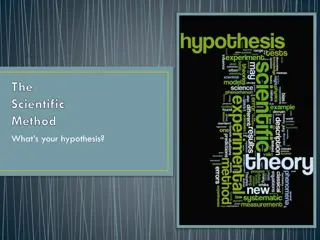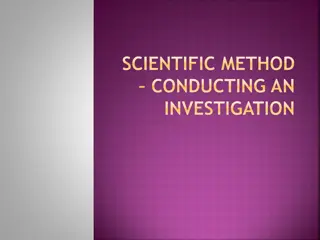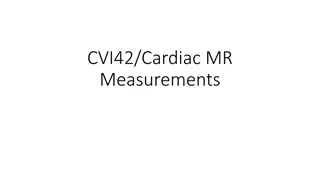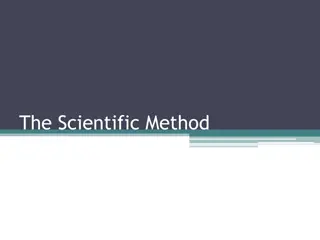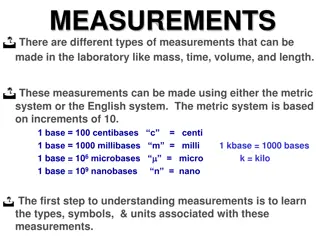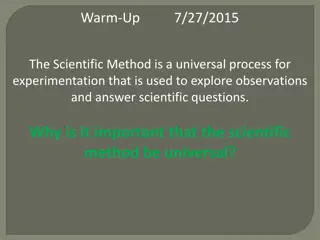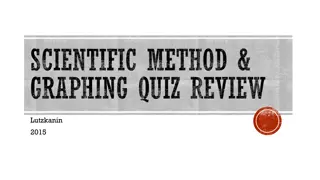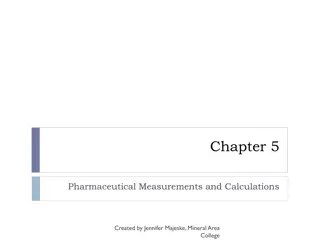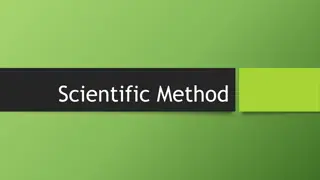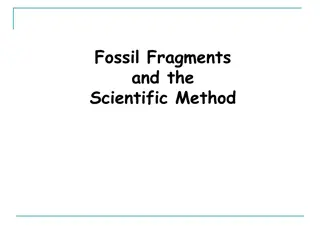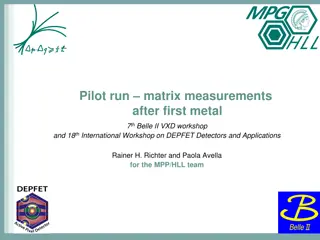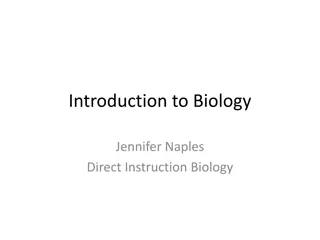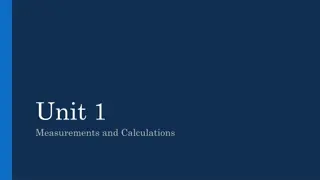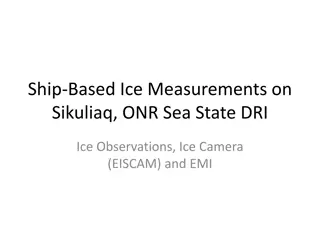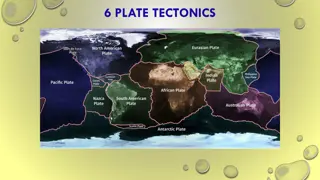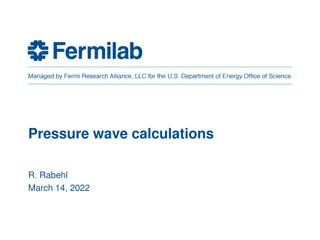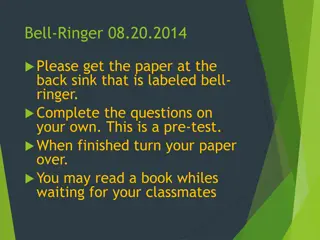Understanding the Scientific Method in Measurements and Calculations
Explore the scientific method in detail, including observing, collecting data, formulating hypotheses, testing hypotheses, and formulating theories with practical examples. Understand the importance of experimentation and how it leads to the development of scientific theories. Engage in activities to apply these concepts and enhance your understanding of scientific processes.
Download Presentation

Please find below an Image/Link to download the presentation.
The content on the website is provided AS IS for your information and personal use only. It may not be sold, licensed, or shared on other websites without obtaining consent from the author. Download presentation by click this link. If you encounter any issues during the download, it is possible that the publisher has removed the file from their server.
E N D
Presentation Transcript
Chapter 2 Measurements and Calculations
Section 1 The Scientific Method
The Scientific Method What is it?? A logical approach to solving problems. 5 Major Parts: Observing and Collecting Data Formulating a Hypothesis Testing the Hypothesis Formulating Theories Supported by Data Publish Results Scientific Method Song
Observing and Collecting Data Observing using the sense to obtain information. Sight, Smell, Touch, Taste, Hear. Collecting Data Two different ways Quantitatively numerical. Example: Mass (30 grams) Qualitatively descriptive, non-numerical. Example: A reaction mixture changes from red to blue. Experimentation carrying out a procedure under controlled conditions to collect data and make observations.
Formulating a Hypothesis Examine and compare data from experiments. Find patterns and relationships in the data. Use generalizations about the data to form a hypothesis, an educated guess. Hypothesis is used as a prediction for further experiments.
Testing the Hypothesis Further experimentation Controls experimental conditions that remain constant Variable experimental conditions that change, or vary. Independent Variable - The variable you change to see how it will affect the dependent variable. Dependent variable The variable that changes according to the changes in the other variable. Data from experiments either supports or refutes hypothesis Support Hypothesis and data is combined to formulate a theory. Refute Hypothesis is modified or discarded.
Formulating a Theory Form an explanation for the question WHY? Scientists use models an explanation of how phenomena occur and how data and events are related. Enough data to support the WHY claim can upgrade a model to a theory. Theory a broad generalization that explains a body of facts. Considered successful if it can predict results of many new experiments.
Activity Step 1 For your experiment, read the problem and state your hypothesis Step 2 design an experiment Step 3 based on the designed experiment, identify: Constants Independent Variable Dependent Variable Control
Section 2 SI Measurements
Scientific notation Scientific notation is a way to write very large or very small numbers Only one nonzero number can appear to the left of the decimal If you move the decimal to the left, the exponent is positive If you move the decimal to the right, the exponent is negative. Negative exponents represent the inverse of a number. Ex 10-3 = 1/1000 = 0.001 11
Scientific notation practice Write the following numbers in scientific notation 560,000 ____________________ 33,400 ____________________ 0.0004120 ____________________ 101.210 ____________________ 0.301 ____________________ 6,967,000 ____________________ 32.1 ____________________ 12 0.000000432 ____________________
Multiplying and Dividing When multiplying numbers in scientific notation, multiply the numbers and add the exponents. (2.15 1015)(5.134 1034) = ___________________ (1.234 10-4)(5.134 102) = ___________________ Dividing Divide numbers first, then subtract exponents 3.12 109 / 4.355 103 = ___________________ 9.10 10-7 / 5.014 102 = ___________________
Addition and Subtraction To add or subtract, move decimal places to that exponents are the same and then carry out the operation. 7.142 105 + 4.12 103 = ___________________ 1.024 10-1 3.12 10-3 = ___________________
SI measurement A measurement must include a value and a unit. Example: 54.3 grams (g) Benefits: Everything goes by 10 s. Standard naming Calculations and conversions are easier to perform. 15
Significant Figures (Sig Figs) What are they? The minimum number of digits required to report a value without loss of accuracy. Why are they useful? They tell us how good the data are that we are using. For example: If a scientist reports the mass of a compound, which is more accurate? 100.3574 g? 100 g 100.3 g
Significant Figures (Sig Figs) Rule Example 1.) Zeros appearing between non-zero digits are significant. 2.) Zeros appearing in front of all nonzero digits are not significant. 3.) Zeros at the end of a number and to the right of the decimal place are significant. 4.) Zeros used as placeholders are not significant. 5.) A decimal point placed after zeros indicates that they are significant. a. 40.7 has three sig figs. b. 56,007 has five sig figs. a. 0.023154 has five sig figs. b. 0.00002 has one sig fig. a. 85.00 has four sig figs a. 2000 has one sig fig b. 34,000 has two sig figs a. 2000. has four sig figs b. 35,000. has five sig figs
Significant figures examples How many significant figures are in each of the following measurements? 28.6 g _________ 3440. cm _________ 910 m _________ 0.04604 L _________ 0.0067000 kg _________ Suppose the value seven thousand centimeters is reported, how would you express the number to . . . 1 significant figures _______________ 4 significant figures _______________ 6 significant figures _______________ 19
Significant figures cntd. Addition and subtraction the answer must have the same number of digits to the right of the decimal as the number having the fewest number of digits to the right of the decimal Look to the right of the decimal Fewest number of decimal places wins. Multiplication and division the answer must have the same number of digits as the number having the fewest number of digits Look at the entire number Least number of digits wins 20
Examples Carry out the following calculations. Express each answer to the correct number of significant figures. 5.44 mL 2.6103 mL = 2.4 m x 15.82 m = 2.099 g + 0.05681 g = 87.3 cm 1.655 cm = Calculate the volume of a rectangular prism that measures 1.34 mm by 0.7488 mm by 16.894 mm. 21
Prefixes Prefixes are used to identify quantities that are much higher or much lower than the base units PREFIX SYMBOL MULTIPLYING FACTOR Kilo- Hecto- Deca- BASE UNIT Deci- Centi- Milli- Micro Nano Pico K h da BASE UNIT d c m n p 1,000 100 10 BASE UNIT 0.1 0.01 0.001 0.000001 0.000000001 0.000000000001 22
Converting We can use conversion factors in order to convert from one unit to another. Conversion factor is defined as a ratio derived from the equality between two different units. Example: 4 ???????? 1 ?????? = 1 Use conversion factors to cancel units and arrive at the unit you want. 1 ?????? 4 ???????? = 1 Ex. 5000 mg to g
Converting Start with the GIVEN Set your conversion line up Write your units, so the units will cancel Put a 1 with the largest unit Put the equivalent conversion factor with the smaller unit ALWAYS stop at the base unit!!!!!! Multiply across the top and multiply the bottom
Practice Complete the following conversions: 10.5 g = ______________ kg 1.57 pm = ______________ m 1.2 L = ______________dL 78.3 cJ = _______________ kJ 323 mJ = _______________ nJ 25
White board practice Complete the following conversions: 890 L = ______________ mL 5.234 km = _______________ cm 48.9 hg = _______________ kg 0.0658 kg = _______________ mg
Volume (V) amount of space occupied by an object Two ways to measure the volume of solids: 1.) Regularly-shaped Measure length, width, and height then multiply. 2.) Irregularly-shaped Must measure using displacement of water. Units of measurement for volume: m3, cm3, mL 1 mL = 1 cm3
Volume problems 50 mL of water was added to a 100 mL beaker. A rock was added and the water level rose to 55.5 mL. What is the volume of the rock? Calculate the volume of a dresser having a length of 1.2 m, a height of 1.98 m, and a depth of 0.60 m. 29
Density The measurement of the ratio of mass to volume of a substance. ? =? ? For solids, g/cm3 For liquids, g/mL
Density problems 1. What is the density of an 84.7 g sample of an unknown substance if the sample occupies 49.6 cm3? 2. What volume would be occupied by 7.75 kg of this same substance? 31
Density white boarding 1. What is the density of a block of marble that occupies 310 cm3 and has a mass of 853 g? 2. Diamond has a density of 3.26 g/cm3. What is the mass of a diamond that has a volume of 0.351 cm3? 3. What is the volume of a sample of liquid mercury that has a mass of 76.2 g, given that the density of mercury is 13.6 g/mL? 32
Temperature Temperature the quantity of the energy of motion of the particles that make it up Three scales C, F, K (no degrees sign for Kelvin) Melting point for water: 0 C, 32 F, 273.15 K Boiling point for water: 100 C, 212 F, 373.15 K K = C + 273.15 33
Dimensional Analysis What is it? A way to use units to solve mathematical problems involving measurements. Quantity sought = quantity given conversion factor How many quarters are in 12 dollars?
Dimensional Analysis Problems 1.) How many nickels are in 56.32 dollars? 2.) How many seconds are in 3.23 years? 3.) How many centimeters are in 2.5 miles (1 mile = 1.61 km)? 35
More practice conversions 1 min = 60 sec 1 kg = 2.2 lbs 1 kg = 1000 g 52 weeks = 1 yr 1 yd = 36 inches 1 ton = 2000 lbs 1 gal = 3.79 L 1 lb = 16 oz 2.54 cm = 1 in 1 cc is 1 cm3 1 hr = 60 min 24 hrs = 1 day 1 mi = 5,280 ft 365 days = 1 yr 7 days = 1 week 264.2 gal = 1 cubic meter 20 drops = 1 mL 1 L = 1000 mL Convert 5.93 cm3to m3 0.621 mi = 1.00 km 1 mL = 1 cm3 How fast is 50 mph in km/sec? Traveling at 65 miles/hour, how many feet can you travel in 22 minutes?
White boarding Practice 1 min = 60 sec 1 kg = 2.2 lbs 1 kg = 1000 g 52 weeks = 1 yr 1 yd = 36 inches 1 ton = 2000 lbs 1 gal = 3.79 L 1 lb = 16 oz 2.54 cm = 1 in 1 cc is 1 cm3 1 hr = 60 min 24 hrs = 1 day 1 mi = 5,280 ft 365 days = 1 yr 0.621 mi = 1.00 km 7 days = 1 week 264.2 gal = 1 cubic meter 20 drops = 1 mL 1 L = 1000 mL 1 mL = 1 cm3 1. 1 mL of ink can print 50 pages of text. If you had 100 gallons of ink then how many pages could you print? 2. The moon is 384,403 km from the earth. Estimate how many quarters laid end to end it would take to reach the moon if a quarter has a diameter of 2.3 cm. 3. The distance from a Port Huron to the Indiana State line is approximately 271 miles (via I-94). Express this distance in kilometers.
Section 3 Using Scientific Measurements
Accuracy and Precision Accuracy how close a measurement is to the actual accepted value. Precision how close together a group of measurements are.
Percentage Error Used to determine the accuracy of a measurement. % error = Valueexperimental V?lueaccepted V?lueaccepted 100 Example: A students measures the mass and volume of a substance and calculates its density to be 1.35 g/mL. The actual density of the substance is 1.30 g/mL. Calculate the percentage error of the student s measurement.
Representing data Direct Relationship as one value increases, the other value increases; dividing one value by the other gives a constant value Indirect relationship or inverse relationship as one value increases, the other value decreases; the product of these two values is constant 42
Direct Relationship Indirect Relationship 43




